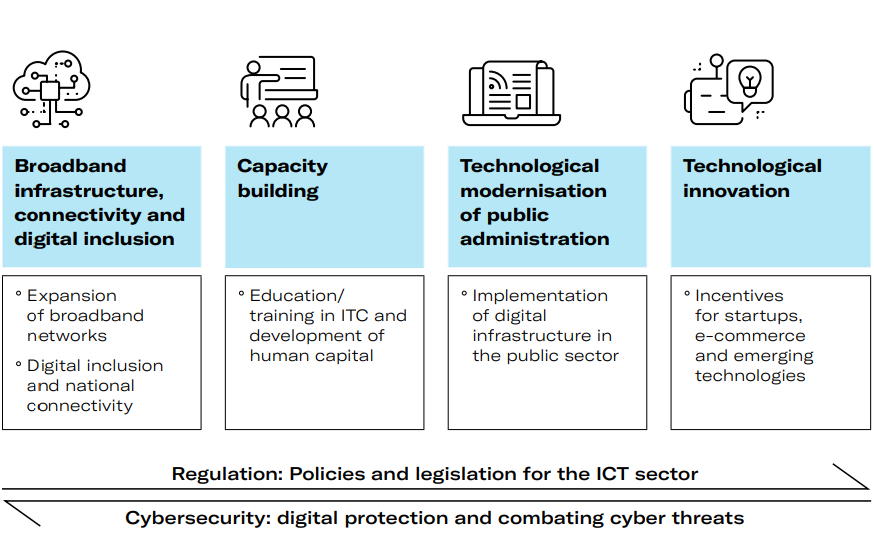- within Media, Telecoms, IT and Entertainment topic(s)
- in United States
- with readers working within the Banking & Credit industries
- in United States
- with readers working within the Retail & Leisure industries
- within Insurance, Law Department Performance and Environment topic(s)
1. Introduction
On 5 December 2024, the new White Paper on Information and Communication Technologies for the period 2023 to 2027 1 (Livro Branco das Tecnologias de Informação e Comunicação - "LBTIC" 2023-2027), called "the path to digital acceleration and transformation in Angola", was approved. This new law repeals all previous legislation that contradicts its provisions, including the White Paper on Information and Communication Technologies for the period 2019 to 2022 2, approved by Presidential Order 129/19 of 22 July (LBTIC 19-22).
The LBTIC 2023-2027 defines the political and strategic measures for the information and communication technology (ICT) sector, based on the strategic planning that includes the Long Term Strategy for Angola (ELP Angola 2050), the National Development Plan 2023-2027 (PDN 2023-2027), the African Union's Agenda 2063, the Connect 2030 Agenda, approved by the International Telecommunications Union and the SADC Digital 2027.
In order to ensure that it reflects the current needs and challenges of the ICT sector in Angola, the Ministry of Telecommunications, Information Technology and Social Communication (MINTTICS) submitted the draft LBTIC 2023-2027 for public consultation in March 2024.
In general, the LBTIC 2023-2027 fits into the hierarchy of planning, policy and strategic instruments for the promotion of the country's socio-economic development, from the perspective of ICT, the growth and development of the digital economy, job creation, the promotion of public-private partnerships, and is therefore influenced by a number of international commitments whose scope in terms of development requires their integration into the sector's planning instruments. In addition, The LBTIC 2023-2027 is based on international instruments for defining ICT strategies, with the aim of promoting the country's digital transformation.
The update of the LBTIC 2023-2027 therefore aims to achieve five fundamental objectives by 2027, namely:
- Provide faster, more reliable communications at more affordable prices;
- Support strategic investments in ICT infrastructure and services to boost the sector;
- Improve ICT skills, employment and entrepreneurship;
- Ensure more effective regulation to improve the ICT business environment; and
- Consolidate institutions to ensure better control over the use of personal data and information society services.
2. Importance of the LBTIC 2023- 2027 in the ICT Sector
The LBTIC 2023-2027 plays a crucial role in the National Development Plan (PDN) 2023- 2027, as it defines the guidelines for the digital transformation and modernisation of telecommunications in Angola. In line with the Angola 2050 strategy, it aims to promote digitalisation and new technologies, contributing to sustainable development and compliance with international commitments in the field of ICT and the information society.
The LBTIC focuses on digital inclusion and human capital development to achieve more inclusive and equitable growth. The LBTIC 2023-2027 also anticipates the transition to the society of the future (Society 5.0) and aims to ensure convergence between the physical and virtual worlds, with a focus on technologies such as Artificial Intelligence (AI), the Internet of Things (IoT), Big Data and Blockchain. Its implementation is essential to ensure sustainable territorial development in Angola.
3. Vision and strategy for the ICT sector in Angola for 2023-2027
The vision and strategy for the ICT sector focuses on the continued development of telecommunications and information technology infrastructures, with the aim of reestablishing Angola as a co-leader in ICT in the Southern African Development Community (SADC) region and ensuring its active participation in the regional free trade area.
The document highlights several strategic actions, including:
- Infrastructure development: Continued investment in telecommunications infrastructure, such as satellite, fibre optics and submarine cables, to create a robust and resilient National Broadband Network (NLBN).
- Promoting digital literacy: Initiatives to improve digital literacy and empower Angolan citizens in the transition to an intelligent society.
- Regulation and policy: Review and update of policies and regulations to ensure a favourable business environment and the protection of personal data.
At the same time, the Executive anticipates the challenges and opportunities that the implementation of the strategic policies will present:
- Macroeconomic challenges: Low levels of GDP growth, high interest rates and inflation rates, and difficulties in attracting private investment.
- Development opportunities: Increased direct and indirect investment in the ICT sector to foster innovation, improve the quality of services and ensure universal access to broadband.
4. Strategic axes of action for the future of ICT in Angola
Digitalisation is an imperative for building an advanced society, the achievement of which requires coordination and the establishment of central pillars for its realisation.
The LBTIC 19-22 proposed only one central pillar to achieve digitisation and inclusion through four pillars of intervention spread over thirty-eight initiatives focusing on infrastructure, connectivity and digital inclusion, technological modernisation of public administration, regulation, innovation and improvement of technological infrastructure, modernisation of public services, promotion of digital inclusion and implementation of effective governance.
The document highlights several strategic actions, including infrastructure development and regulation and policy
The LBTIC 2023-2027, on the other hand, is more comprehensive and innovative in this field, proposing two central pillars, the first with four intervention pillars and the second with two intervention pillars, with a total of forty-seven initiatives divided between the two intervention pillars to achieve the central pillars and, consequently, digitalisation.
In order for the digital transformation in Angola to enable the construction of an intelligent society that promotes social, economic and human capital development, the Executive intends to strengthen its commitment to telecommunications/ICT as strategic pillars, adopting advanced technologies that support structural changes in the state apparatus and take advantage of the opportunities of the digital economy. The implementation of this vision is based on six fundamental axes: four vertical - broadband infrastructures, capacity building, technological modernisation of public administration and technological innovation - and two horizontal - regulation and cybersecurity, as shown in the following figure.
Transformação Digital e Sociedade Inteligente

4.1. BROADBAND INFRASTRUCTURE, CONNECTIVITY AND DIGITAL INCLUSION
With regard to this first axis, the Angolan government plans to develop the national broadband network, Internet interconnection points and new generation networks, create accreditation and certification bodies, improve the state's private network and modernise public administration, develop the satellite telecommunications system as part of the national space programme and transition to digital broadcasting and universal service and universal access.
In order to achieve these objectives, it will be necessary to continue to invest in infrastructure projects to promote a quality infrastructure that guarantees national and international connections. In particular, it is essential to implement a robust infrastructure that covers the entire national territory and guarantees the international connections needed to integrate Angola into the global context.
This initiative not only reflects national goals, but is also in line with international commitments such as the CPLP Digital Agenda, the SADC Digital Agenda 2027, the SADC Satellite Sharing Network, the African Union's Agenda 2063 and the UN's 2030 Agenda for Sustainable Development, and the International Telecommunications Union's Connect 2030 Agenda.
4.2.TRAINING
The aim is to focus the executive's actions on implementing an ICT-oriented education model for Angola's economic, social and cultural development. The development of this pillar therefore includes actions to strengthen ICT content and subjects in primary, secondary and university education, in order to familiarise the population with the use of digital tools. Also in this line of action, the Executive intends to promote actions to raise awareness and train citizens, especially children and young people, in the safe and responsible use of ICT, focusing on themes such as citizenship and digital literacy to encourage the development of digital skills.
4.3. TECHNOLOGICAL MODERNISATION OF PUBLIC ADMINISTRATION
According to the LBTIC 2023-2027, the Executive intends to promote the implementation of IT systems to modernise and simplify the public administration, using information technologies as a priority means of providing services to citizens, economic operators and institutions.
The implementation of this axis will allow the strategic use of ICT to boost the economy, the competitiveness of businesses and the quality of life of citizens. It is therefore essential to invest in various sectors such as health, ICT in construction, public works, town and country planning and housing, agriculture, the modernisation of public administration and the implementation of governance, supported by an appropriate technological infrastructure to promote interoperability between the various public bodies.
At the heart of innovation are not only the autonomous processes of research and technological development, but also the transfer of this knowledge and technology to the business sector.
4.4. TECHNOLOGICAL INNOVATION
In this context, the Executive recognises that at the heart of innovation are not only the autonomous processes of research and technological development, but also the transfer of this knowledge and technology to the business sector.
The main challenges in promoting technological innovation include the following:
- Adopt the National Strategy for e-Start-ups to provide institutional support for the strengthening of youth initiatives and stimulate the creation of entrepreneurs in the ICT sector.
- Encourage e-commerce by creating solutions that integrate technology and creativity at lower operational costs, thus boosting e-commerce in the country.
- Encourage the growth of over-the-top services, mobile money, application development and disruptive platforms. The promotion and implementation of mobile payment platforms is considered fundamental, taking into account aspects related to converging technologies in the adoption and applicability of mobile payment solutions throughout Angola.
- Implement solutions for emerging technologies (IoT, Big Data, AI, Blockchain and 5G), as Angola needs to keep up with technological developments, which requires the creation of favourable conditions for the development of so-called smart cities.
- Implement a National Artificial Intelligence Strategy (ENIA), as this technology is a valuable tool for accelerating the achievement of the United Nations Sustainable Development Goals (UN SDGs) and national development goals. Consequently, the Angolan Executive recognises the potential of AI for various purposes, including boosting economic growth, having a direct impact on improving people's quality of life and livelihoods, and fostering a digital ecosystem.
- In this context, ENIA should promote the development and use of this technology to advance scientific progress. ENIA will mainly focus on aspects related to the retraining of the workforce, university education and research in AI, and the creation of protocols with universities to promote education and applied research in AI, attract researchers and enable the establishment of partnerships with global institutions.
5. Development of the digital economy and the role of telecommunications
The development of the digital economy in Angola aims to promote digital inclusion, stimulate innovation and improve the business environment, with a focus on creating disruptive models that contribute to eradicating poverty and reducing the digital divide. According to the Executive's vision, the implementation of digital platforms will depend on trust and legal certainty in commercial relations in the ICT sector, with an emphasis on innovation, cooperation and strengthening the national digital economy.
To this end, reforms and increased regulation of the broadband market are planned to ensure competition and the universalisation of services. The state intends to reduce its presence in the market and focus more on regulating and promoting private investment, while strengthening the regulator's capacity to ensure market efficiency.
One of the objectives of the LBTIC is to open up the broadband market to competition, with the participation of Angolan and foreign investors. The state also intends to gradually divest its shareholdings in companies in the sector, especially in mature and self-sustaining areas. In addition, the licensing policy will be adapted to new technologies to ensure the efficient use of resources such as radio frequencies and IP addresses.
Ongoing reforms will also be pursued, including the sharing of infrastructure, the regulation of essential facilities and the promotion of efficiency in the use of resources. Strengthening e-governance and modernising public administration will also be a priority, with a focus on improving public services and promoting digital interaction between citizens and the administration.
The creation of favourable conditions for the development of the broadband market will be supported by tax incentives and the implementation of the Communications Development Support Fund, which will ensure the expansion of universal access to digital services, especially in hard-to-reach areas.
5.1. MEASURES TO ENSURE COMPETITIVENESS, INNOVATION AND UNIVERSAL ACCESS IN TELECOMMUNICATIONS
In order to achieve the strategic objectives relating to the telecommunications sector in the period 2023-2027, it is intended to adopt various measures, including those listed below.
5.1.1. Strengthening the regulation of the broadband market
Regulation of the broadband market will play a fundamental role in ensuring a competitive and sustainable environment in the telecommunications sector. The executive should ensure that competition is promoted by opening up the market and involving national and foreign investors. The regulatory authority must be strengthened by increasing its technical and administrative powers to monitor the application of market rules and ensure transparency in operations.
The specific objectives to be achieved within this framework are:
- Guarantee free competition, avoiding monopolistic or unfair practices;
- Ensure compliance with quality standards for broadband services, including coverage and accessibility at fair prices;
- Establish and implement inspection mechanisms to ensure that companies in the sector comply with the standards set by the government.
5.1.2. Updating the licensing and regulatory framework for broadband networks and services
The LBTIC 2023-2027 states that the licensing model for access to activities in the telecommunications sector will be adapted in line with new technologies and network convergence. In addition, the licensing of broadband operators must include new approaches that integrate technological advances and the specific needs of less developed areas, such as the scarcity of radio spectrum resources and IP numbering.
Planned measures:
- Update licensing models to include new technologies such as 5G, fibre optics and advanced mobile data services;
The executive should ensure that competition is promoted by opening up the market and involving national and foreign investors
- Set specific coverage requirements for rural and hard-to-reach areas to incentivise the roll-out of services;
- Regulate the radio spectrum to ensure efficient management of the limited resource and equitable use of spectrum.
5.1.3. Regulating the regulatory framework applicable to the sharing and installation of telecommunications infrastructures
According to the LBTIC 2023-2027, the definition of an infrastructure sharing policy is essential to optimise the use of available resources and rationalise investments. Sharing infrastructure, such as antenna masts, ducts and technical areas, will enable electronic communications companies to reduce operating costs and facilitate network roll-out, especially in remote areas.
Sound regulation of the sharing of telecommunications networks and services will therefore be essential to ensure the efficient use of resources. This implies the creation of specific legislation that encourages cooperation between operators, ensuring that all market players benefit from the rationalisation of resources. The development of telecommunications will depend on the regulation of physical infrastructure, such as ducts, access points to buildings and network equipment, to ensure the orderly and efficient expansion of telecommunications networks.
Planned measures:
- Establish rules for sharing infrastructure, such as ducts, antennas and technical areas, to optimise the use of resources and reduce operating costs;
- Establish a legal framework to incentivise the sharing of convergent services, such as voice, data and digital television, between different providers.
- Define the conditions and legal incentives for sharing infrastructure between different operators, ensuring that the processes are transparent and efficient;
- Establish a regulatory framework for the sharing of resources such as telecoms masts and ducts, encouraging cooperation between operators;
- Establish standards for the construction and rehabilitation of infrastructure to integrate telecommunications networks into new construction projects for public roads, buildings and other infrastructure;
- Establish rules for access to private and public buildings and homes to allow the installation of telecommunications networks and ensure coverage throughout the territory;
- Create technical standards to guarantee the quality and durability of the infrastructures used to install telecommunications networks.
5.1.4. Development and implementation of an e-governance policy
E-government is an important pillar for modernising public administration and facilitating citizens' access to public services. In this sense, the LBTIC 2023-2027 states that the regulation of the use of digital platforms in the public sector is fundamental for the interoperability and security of online services.
Planned measures:
- Adopt legislation on the digital platforms used by the public administration to ensure that they meet security, privacy and accessibility requirements;
- Establish policies to ensure interoperability between public administration information systems and private platforms, promoting efficient and unhindered administration;
- Establish standards to ensure IT security and privacy in digital services provided by the public administration, including the use of electronic signatures and the establishment of Cyber Security Incident Response Centres (CSIRTs).
- Establish and operate an Accreditation and Certification Authority: The establishment of this public authority aims to ensure the security and reliability of electronic documents in the context of e-governance. With powers to issue, renew and cancel credentials, as well as to supervise certifying entities, this body will guarantee reliability in commercial and administrative relations through the use of digital signatures and time stamps.
Footnotes
1 Approved by Presidential Decree 272/24 of 5 December.
2 Approved by Presidential Decree 129/19 of 22 July
To view the full article click here
The content of this article is intended to provide a general guide to the subject matter. Specialist advice should be sought about your specific circumstances.



